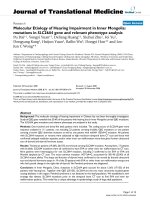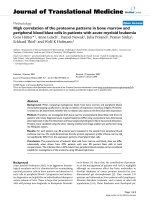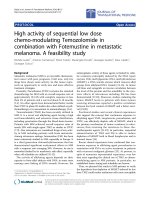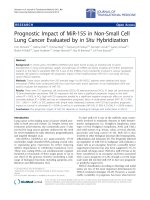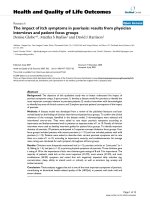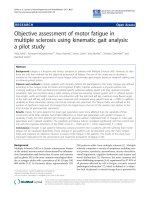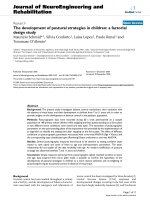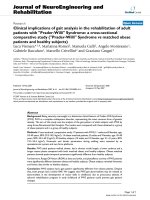báo cáo hóa học:" High abundances of neurotrophin 3 in atopic dermatitis mast cell" pdf
Bạn đang xem bản rút gọn của tài liệu. Xem và tải ngay bản đầy đủ của tài liệu tại đây (387.26 KB, 7 trang )
BioMed Central
Page 1 of 7
(page number not for citation purposes)
Journal of Occupational Medicine
and Toxicology
Open Access
Research
High abundances of neurotrophin 3 in atopic dermatitis mast cell
David Quarcoo*
1
, Tanja C Fischer
2
, Nora Peckenschneider
3
,
David A Groneberg
1
and Pia Welker
3
Address:
1
Institute of Occupational Medicine, Charité – Universitätsmedizin Berlin, Free University and Humboldt University, D-14195 Berlin,
Germany,
2
Department of Dermatology and Allergy, Charité – Universitätsmedizin Berlin, Free University and Humboldt University, D-10115
Berlin, Germany and
3
Institute of Anatomy, Charité – Universitätsmedizin Berlin, Free University and Humboldt University, D-10115 Berlin,
Germany
Email: David Quarcoo* - ; Tanja C Fischer - ;
Nora Peckenschneider - ; David A Groneberg - ;
Pia Welker -
* Corresponding author
Abstract
Background: Neurotrophin 3 (NT-3) is a member of the neurotrophin family, a group of related
proteins that are known to regulate neuro-immune interactions in allergic diseases. Their cellular
sources and role in the recruitment of mast cell precursors in atopic dermatitis have not been
characterized in detail so far.
Objective: Characterize NT-3 on a transcriptional and translational level in individuals with atopic
dermatitis with special focus on mast cells.
Methods: To meet this objective NT-3 levels in the serum of AD patients were measured, the
effect of NT-3 on keratinocytes was evaluated and the gene expression and regulation assessed
using ELISA, immunohistochemistry and RNA quantification.
Results: Systemic levels of NT-3 were found to be higher in individuals with AD as compared to
healthy controls. A distinct genetic expression was found in the various cells of the skin. In lesional
mast cells of individuals with atopic dermatitis an increased amount of NT-3 was apparent.
Functional in vitro experiments demonstrated that NT-3 stimulation led to a suppression of IL-8
secretion by HaCat cells.
Conclusion: These findings could imply a role for NT-3 in the pathogenesis of allergic skin
diseases.
Introduction
The atopic dermatitis (AD) is a persistent relapsing
inflammatory skin disease associated with dry skin, itch-
ing and an ever increasing prevalence, particularly in the
age group of early childhood [1]. AD has been grouped
into an intrinsic and extrinsic type according to the pres-
ence of IgE-mediated sensitization which is found in the
extrinsic type. Accumulating Data have suggested that the
nervous system influences the course of AD through emo-
tional stress, altered patterns of skin innervation, and
abnormal expression of neuromediators [2,3]. Neuro-
trophins, a family of structurally and functionally related
polypeptides, act as mediators in the interactions between
both immune and nerve cells [4]. The effect of neuro-
Published: 22 April 2009
Journal of Occupational Medicine and Toxicology 2009, 4:8 doi:10.1186/1745-6673-4-8
Received: 16 October 2008
Accepted: 22 April 2009
This article is available from: />© 2009 Quarcoo et al; licensee BioMed Central Ltd.
This is an Open Access article distributed under the terms of the Creative Commons Attribution License ( />),
which permits unrestricted use, distribution, and reproduction in any medium, provided the original work is properly cited.
Journal of Occupational Medicine and Toxicology 2009, 4:8 />Page 2 of 7
(page number not for citation purposes)
trophins is mediated by two types of receptors that vary in
terms of ligand binding specificity. While the low affinity
neurotrophin receptor P75 is capable of binding to all
neurotrophins with equivalent affinity, tyrosine kinase
(Trk) family members exhibit ligand selectivity. The TrkC
receptor appears be unique in binding only one type of
neurotrophin and none of the other related ligands [5].
The bound ligand, neurotrophin (NT)-3 is a 119 amino
acid basic protein and has about 50% homology to the
nerve growth factor (NGF) as well as to the brain-derived
neurotrophic factor (BDNF) and NT-4, three other mem-
bers of this family [6]. NT-3 binds to TrkC as its high affin-
ity tyrosine kinase receptor and shows low affinity
interactions with the low affinity NT receptor P75 and
TrkA and TrkB, the high affinity receptors for NGF and
BDNF/NT-4, respectively [7]. From cells that can be found
in the skin, fibroblasts and human epidermal keratinoc-
ytes produce NT-3 in vitro [8]. Also, NT-3 acts as a growth
factor for human melanocytes in vitro [9].
Bone marrow-derived, tissue resident mast cells have been
shown to increase in numbers in a wide variety of inflam-
matory and neoplastic conditions. They play a central role
in the pathogenesis of AD [10]. It has been demonstrated
that the interaction between mast cells and nerves in
patients with AD is mediated by neuropeptides like sub-
stance P, calcitonin gene related peptide or vasoactive
intestinal peptide [2-4]. In addition, there is recent evi-
dence that besides these short peptides also NTs are
potentially mediators of nerve-mast cell interaction. Skin
mast cells were described to release NGF [11,12] and the
human mast cell line (HMC-1) produces besides NGF
also BDNF and NT-3 [13]. In the same article it was also
shown, that HMC-1 cells express the NT receptors TrkA,
TrkB and TrkC [13]. Therefore, mast cells are not only a
source, but also possible effector for NTs. Up to the
present, there are only rare information which other kinds
of cutaneous cells are able to produce NTs [14,15]. NGF is
expressed by several cell types such as keratinocytes,
fibroblasts and melanocytes [16]. One study demon-
strated the up regulation of NT-4 expression in the kerati-
nocytes of skin from patients with AD, whereas NT-3,
expressed in dermal fibroblasts, remained unchanged
[17].
Here we investigate which skin cell types have the capacity
to produce NT-3 to obtain more information about the
network of NTs as a part of the cytokine network in the
skin. Modified expression in the skin of patients with AD
compared to normal skin give new insides in the role of
NT in the pathogenesis of this disease.
Methods
Tissue
Biopsies from 45 patients with atopic dermatitis (>16
years, mean age 38.5 years, 24 females, 21 males) and 23
normal controls (>16 years, mean age 42.8 years, 13
females, 10 males) were examined. Atopic dermatitis
diagnosis was based on the criteria of Hanifin [18], and
routinely performed histopathological examination
revealed characteristic inflamed eczematous lesions. The
SCORAD of the atopic dermatitis patients was >25 (mod-
erate or severe). Cutaneous keratinocytes, endothelial
cells, fibroblasts, melanocytes, and MC were obtained
from human foreskin or breast skin of non-atopic patients
undergoing cosmetic surgery and isolated as described
previously [19]. The skin MCs were enriched (95% purity)
using immunobeads (Dynal, Hamburg, Germany) coated
with a c-Kit antibody YB5.B8 and magnetic cell sorting
[20]. The human HaCaT keratinocytes cell line was kindly
provided by N. Fuseing (Heidelberg, Germany) [21]. All
studies were performed according to the declaration of
Helsinki, after patients had given their informed consent.
RNA-Isolation
1 × 10
6
cells were lysed and total RNA was prepared using
the RNeasy-total-RNA-kit (Qiagen, Hilden, Germany).
After digestion of genomic DNA by treatment with
DNAase, cDNA was synthesized by reverse transcription
of 5 μg total RNA, using a cDNA synthesis kit (InVitrogen,
Stade, USA).
Reverse-Transcription Polymerase Chain Reaction
The following sets of oligonucleotide primers were used
to amplify cDNA (expected fragment lengths are given in
parenthesis): GAPDH: 5' GAT GAC ATC AAG AAG GTG
GTG and 5'GCT GTA GCC AAA TTC GTT GTC (197 bp)
[19]; NT-3: 5'CCGCCCTTGTATCTCATGGA, and 5'CCGT-
GATGTTCTGTTCTGTCGCC (354 bp) [22]. Amplification
was performed using Taq polymerase (GIBCO) over 24–
38 cycles with an automated thermal cycler (Perkin Elmer,
FRG). Each cycle consisted of the following steps: denatur-
ation at 94°C, annealing at 58°C (GAPDH), 63°C (NT-3)
and extension at 72°C for 1 min each. PCR products were
analyzed by agarose gel electrophoresis and enzymatic
digestion, using standard techniques.
Immunocytochemical staining
Anti-NT-3 monoclonal antibodies were used (1:100, rab-
bit, sc-547 from Santa Cruz Biotechnology, Santa Cruz,
USA) to perform immunohistochemistry using the
APAAP technique. To quantify mast cell numbers and
assess mast cell p75 staining intensity, previously
described and validated protocols were used [23]. In brief,
sections were evaluated by two independent investigators.
Counting of nucleated stained cells was performed using
a raster covering 1/16 mm
2
at 1: 400 magnifications in at
Journal of Occupational Medicine and Toxicology 2009, 4:8 />Page 3 of 7
(page number not for citation purposes)
least five microscopic fields. Counts were expressed as
stained cells per mm
2
. Quantification of mast cell staining
intensity for neurotrophins and their receptors was per-
formed using an intensity ranging from 0 to 3.5, as previ-
ously described and validated [24-26]. Measurement of
intensity was performed for at least four slides of each
patient and control subject in a blinded fashion.
Cell culture and stimulation
Human HaCaT keratinocyte cells were kept in Dulbeccos
Eagle's medium (Gibco, Karlsruhe, Germany), supple-
mented with 5% fetal bovine serum (Biochrom, Berlin,
Germany), 4 mM glutamine, and 100 U penicillin and
streptomycin per mL (both from Gibco, Karlsruhe, Ger-
many) [21]. Cells were seeded at 2 × 10
6
cells/cm
2
in cul-
ture plates, and the medium was routinely changed every
3 or 4 days. As described, in some experiments, the
medium was removed after 3 day of culture and, follow-
ing another 24-h culture with different concentrations of
NT-3, the supernatants were collected to compare the IL-8
quantities.
Cytokine measurements
Serum NT-3 levels in serum of individuals with AD (n =
10) were compared with healthy controls (n = 12) using a
commercially available ELISA kit from R&D Systems
(Minneapolis, USA). Cell supernatants were analyzed for
IL-8 contents with a commercially available enzyme-
linked immunoabsorbent assay, ELISA Kit (Quantikine,
R&D systems, Bad Nauheim, Germany). Values of dupli-
cate measurements fluctuated within a very narrow mar-
gin (< 5%). The results were adjusted to viable cell counts
and expressed as means ± SD of four different experi-
ments.
Statistics
Results of the different parameters and groups are
expressed as mean ± s. e. m unless stated differently. Sta-
tistical significance was calculated using the unpaired two-
tailed t-test.
Results
NT-3 serum levels in individuals with AD
Serum NT-3 levels in serum of individuals with AD were
compared with healthy controls using a commercially
available ELISA kit. As depicted in Fig. 1 significantly
higher amounts of NT-3 were found in the serum of the
AD group as compared to the control group.
NT-3 mRNA expression in cutaneous cells
To assess the cellular expression of NT-3 mRNA in human
skin of non-atopic patients, different cell populations
were freshly isolated and subjected to RT-PCR. Using NT-
3 specific primer pairs, repeated (n = 4) RT-PCR experi-
ments were performed and NT-3 specific amplification
products with a length of 354 bp were detected in differ-
ent cell types. Strong NT-3 specific mRNA signals were
present in mast cells, keratinocytes, and fibroblasts,
weaker signals were found in melanocytes, whereas in
endothelial cells no signal was detected (Fig. 2). The PCR
product identities were confirmed by direct sequencing,
which revealed identity with the published sequences
(Data not shown).
Mast cell-specific of NT-3 expression in normal and
lesional topic dermatitis skin
To assess the protein expression of NT-3 in human skin in
situ, NT-3 immunohistochemistry was performed, lead-
ing to the identification of NT-3 in MCs of both normal
and atopic dermatitis MCs. The transcriptional regulation
of NT-3 in lesional MCs of atopic dermatitis patients was
assessed using quantitative immunohistochemistry, and
significant changes in protein expression were found
between normal and atopic dermatitis MCs. Quantitative
immunohistochemistry demonstrated significant changes
NT-3 protein plasma levelsFigure 1
NT-3 protein plasma levels. Plasma levels of NT-3 [in ng/
ml] in healthy individuals (n = 12) compared to patients with
AD (n = 10) detected by ELISA.
0
1000
2000
3000
4000
5000
6000
7000
8000
9000
10000
nad
Serum NT-3 ng/ml
Healthy AD
control
Journal of Occupational Medicine and Toxicology 2009, 4:8 />Page 4 of 7
(page number not for citation purposes)
in protein expression from 2,0 ± 0.3 (control) to 3.0 ± 0.2
(AD) for NT-3 (p < 0.05) (Fig. 3).
Incubation of HaCaT cells with increasing concentrations
of NT-3
To assess the functional effects of a decreased NT-3 secre-
tion, in vitro studies were performed that assessed the
secretory activity of HaCaT keratinocytes, and significant
differences were found. The secretion of IL-8 in HaCaT
cells after stimulation with different levels of NT-3
decreased in a dose-dependent manner. The reduced NT-
3 stimulation from 10, 1 and 0,1 ng/mL led to an increase
in IL-8 secretion that was significant (P < 0.05) (Fig. 4).
Discussion
In the present study, we have provided evidence that in
atopic dermatitis, NT-3 is up regulated on a systemic level
as well as on a tissue level, suggesting that there is an
increased release of NT-3 in allergic disease of the skin.
Since it's cloning in 1990 by Jones and Reichard the neu-
rotrophin-3 has been for the most part subject of neuro-
science research [27]. Here, complex regulation patterns
were found in regard to outgrow and maintenance of neu-
rons [28,29]. In the ontogenesis a lack of neurotrophin
support leads to specific deficits in sensory neuron
number and peripheral innervation patterns [28,30,31].
Mice that are deficit in NT3 lack up to 70% of their sen-
sory neurons during embryonic development and certain
types of sensory complexes [28].
In the adult organism elevated systemic NT-3 levels have
been linked to various diseases. Thus, Walz et. al. show
that NT-3 was elevated in patients with psychiatric ill-
nesses [32]. In a study investigating the systemic NT-3
level in asthmatic patients the authors not only found an
association between higher levels of NT-3 and the disease,
but also demonstrated a significant drop in the elevated
serum level of the neurotrophin after treatment of the
underlying asthma [33]. In line with the last study in the
current study elevated serum levels of NT-3 were detected
in the AD patients. It has been shown that inflammatory
processes induce NT-3 [34], since in AD this takes place in
the skin it represents a potential site for the systemic NT-3
release.
The roles of NT-3 in the biology of the skin have not been
fully elucidated yet. The best-established role for NT-3 is
the support and maintenance of sensory nerve endings
and accessory organs [35,36]. In the current study NT-3
expression in different cell populations of the skin was
NT-3 mRNA expression in isolated cutaneous cellsFigure 2
NT-3 mRNA expression in isolated cutaneous cells.
Expression of mRNA specific for NT-3 (RT-PCR) in isolated
skin keratinocytes, fibroblasts, endothelial cells, melanocytes,
and mast cells (representative results from four different
experiments).
NT-3
NT-3 expression in atopic dermatitis lesional mast cells: (a) Immunohistochemical staining (APAAP) of normal skin sec-tions (N) and from patients with atopic dermatitis (AD) using specific antibodies against NT-3Figure 3
NT-3 expression in atopic dermatitis lesional mast
cells: (a) Immunohistochemical staining (APAAP) of
normal skin sections (N) and from patients with
atopic dermatitis (AD) using specific antibodies
against NT-3. (40 × magnification). (b) Quantitative analysis
of NT-3 immunohistochemical staining (APAAP) of normal
skin sections and from patients with atopic dermatitis. Black
bars, atopic dermatitis; open bars, controls.
0
0,5
1
1,5
2
2,5
3
3,5
12
staining intensity
A
B
staining intensity
3.50
3.00
2.50
2.00
1.50
1.00
.50
0
p < 0.05
NAD
N
AD
NT-3
NT-3
Journal of Occupational Medicine and Toxicology 2009, 4:8 />Page 5 of 7
(page number not for citation purposes)
demonstrated. Although, other studies that have detected
expression of NT-3 in cell cultures of mast cells and
fibroblasts, a publication by Innominnato et. al. found
that in humans melanocytes expression of NT-3 only took
place after the malign transformation of the cells [37].
In the current study endothelial cells were the only cell
type that did not express NT-3. The expression of neuro-
trophins and their receptors was investigated in large
arteries of the lung and other sites in a study by Ricci and
coworker. It was shown that the expression of NT-3 was
mainly located in the tunica media and tunica adventitia
where it was hypothesis to take part in the regulation of
vascular mobility, owing to the fact that TrkC and P75
were abundantly expressed in vascular smooth muscle
[38]. Lacking the large amount of smooth muscle it might
be assumed that in the skin the expression is low in the
fine dermal vessels.
A study that measured the quantity of neurotrophins in
different tissues throughout life of mice found that NT-3
is not only expressed in various tissues after birth, but also
retains detectable values throughout the lifetime of the
organism. In particular in the thymus, a site inhabited by
cells of the immune system the expression of NT-3
remains high [39]. An emerging body of evidence suggests
that NT-3 is able to interfere in immunological processes.
In this line Barouch and coworker established that NT-3
was not only spontaneously expressed by leukocytes, but
was further increased after the stimulation of the cells
with LPS [34]. A phenomenon found to be also true for
other neurotrophins [40]. The direction of inflammation
played an important role in a study by Besser et. al where
he showed that only human Th2 clones can be stimulated
to release NT-3 by the cytokine IL-4, the paramount Th2
cytokine [41]. Therefore, the release of NT-3 might affect
the activity and direction of an inflammatory process.
Also, NT-3 might enhance survival and triggers the local
immune cells in the skin, a capacity which has been
shown for eosinophiles and monocytes [42]. Also other
cell types, both naive and stimulated have been shown to
express NT-3 [9,43-45]. Mast cells that have been pro-
posed to play an important role in the interface between
the immune and the nervous system are able to express
NT-3 [13]. Metz and coworker demonstrated that more
mast cells can be found in the skin of transgenic mice over
expressing NT-3 [46]. Conversely TrkC knockout mice
present only with a slight reduction in mast cell numbers,
which suggested that NT-3 and its high affinity Trk recep-
tor play a part in up regulating the number of MCs, but do
not control numbers of basal MCs.
In the current study we found evidence for a functional
role for NT-3 in AD. Interestingly, NT-3 stimulation led to
a decreased secretion of IL-8 in HaCaT cells. In a recent
study Nomura et. al. has attributed the down regulation of
pro-inflammatory cytokines like IL-8 to the increased sus-
ceptibility of the AD skin to microorganisms, and sug-
gested a new fundamental rule that may explain the
mechanism for frequent infection in other Th2 cytokine-
mediated diseases [47]. Because previous studies demon-
strated a close interaction between MCs and keratinocytes
in atopic dermatitis [48], it can be assumed that the pres-
ently observed increase in NT-3 production in MCs may
also have functional effect on keratinocytes IL-8 secretion
in states of atopic dermatitis. Enhanced NT-3 levels may
lead to decreased IL-8 production by keratinocytes as
shown by the HaCaT in vitro studies and thus to functional
consequences in AD.
Taken together, the present study presents data on the
expression and function of NT-3 in lesional cutaneous
mast cells in AD, thus providing data proposing possible
regulatory mechanisms involved. Mast cell-nerve interac-
tions may thus contribute crucially to the development
and progression of the chronic inflammatory lesions in
atopic dermatitis.
Abbreviations
AD: Atopic Dermatitis; NT: neurotrophin; MC: mast cell;
Trk: tyrosine kinase; RT-PCR: reverse transcription
polymerase chain reaction; NGF: nerve growth factor;
BDNF: brain derived neurotrophic factor; SCORAD:
SCORing Atopic Dermatitis
Competing interests
The authors declare that they have no competing interests.
Functional effects of increasing NT-3 levels on HaCaT kerati-nocytes secretionFigure 4
Functional effects of increasing NT-3 levels on
HaCaT keratinocytes secretion. Release of IL-8 [in ng/
10
6
cells] after stimulation with different levels of NT-3.
0
0,5
1
1,5
2
2,5
1234
IL-8 ng/ 10
6
cells
*
0 0,1 1,0 10 ng/ml
NT-3
Journal of Occupational Medicine and Toxicology 2009, 4:8 />Page 6 of 7
(page number not for citation purposes)
Authors' contributions
DQ conceived of the study, participated in the design and
co-ordination of the study, interpreted the data and
drafted and prepared the manuscript. TCF and PW helped
to conceived of the study. PW, NP performed the analysis.
DAG and PW helped to interpret the data. All authors read
and approved the final manuscript.
References
1. Leung DY: Pathogenesis of atopic dermatitis. J Allergy Clin Immu-
nol 1999, 104:S99-108.
2. Ostlere LS, Cowen T, Rustin MH: Neuropeptides in the skin of
patients with atopic dermatitis. Clin Exp Dermatol 1995,
20:462-467.
3. Scholzen T, Armstrong CA, Bunnett NW, Luger TA, Olerud JE, Ansel
JC: Neuropeptides in the skin: interactions between the neu-
roendocrine and the skin immune systems. Exp Dermatol 1998,
7:81-96.
4. Marshall JS, Waserman S: Mast cells and the nerves–potential
interactions in the context of chronic disease. Clin Exp Allergy
1995, 25:102-110.
5. Raffioni S, Bradshaw RA, Buxser SE: The receptors for nerve
growth factor and other neurotrophins. Annu Rev Biochem
1993, 62:823-850.
6. Lewin GR, Barde YA: Physiology of the neurotrophins. Annu Rev
Neurosci 1996, 19:289-317.
7. Bothwell M: Functional interactions of neurotrophins and neu-
rotrophin receptors. Annu Rev Neurosci 1995, 18:223-253.
8. Cartwright M, Mikheev AM, Heinrich G: Expression of neuro-
trophin genes in human fibroblasts: differential regulation of
the brain-derived neurotrophic factor gene. Int J Dev Neurosci
1994, 12:685-693.
9. Yaar M, Eller MS, DiBenedetto P, Reenstra WR, Zhai S, McQuaid T,
Archambault M, Gilchrest BA: The trk family of receptors medi-
ates nerve growth factor and neurotrophin-3 effects in
melanocytes. J Clin Invest 1994, 94:1550-1562.
10. Tsai M, Grimbaldeston MA, Yu M, Tam SY, Galli SJ: Using mast cell
knock-in mice to analyze the roles of mast cells in allergic
responses in vivo. Chem Immunol Allergy 2005, 87:179-197.
11. Leon A, Buriani A, Dal Toso R, Fabris M, Romanello S, Aloe L, Levi-
Montalcini R: Mast cells synthesize, store, and release nerve
growth factor. Proc Natl Acad Sci USA 1994, 91:3739-3743.
12. Nilsson G, Forsberg-Nilsson K, Xiang Z, Hallbook F, Nilsson K, Met-
calfe DD: Human mast cells express functional TrkA and are
a source of nerve growth factor. Eur J Immunol 1997,
27:2295-2301.
13. Tam SY, Tsai M, Yamaguchi M, Yano K, Butterfield JH, Galli SJ:
Expression of functional TrkA receptor tyrosine kinase in
the HMC-1 human mast cell line and in human mast cells.
Blood 1997, 90:1807-1820.
14. Botchkarev VA, Botchkareva NV, Welker P, Metz M, Lewin GR, Sub-
ramaniam A, Bulfone-Paus S, Hagen E, Braun A, Lommatzsch M, Renz
H, Paus AR: A new role for neurotrophins: involvement of
brain-derived neurotrophic factor and neurotrophin-4 in
hair cycle control. Faseb J 1999, 13:395-410.
15. Botchkarev VA, Welker P, Albers KM, Botchkareva NV, Metz M,
Lewin GR, Bulfone-Paus S, Peters EM, Lindner G, Paus R: A new role
for neurotrophin-3: involvement in the regulation of hair fol-
licle regression (catagen). Am J Pathol 1998, 153:785-799.
16. Pincelli C, Sevignani C, Manfredini R, Grande A, Fantini F, Bracci-Laud-
iero L, Aloe L, Ferrari S, Cossarizza A, Giannetti A: Expression and
function of nerve growth factor and nerve growth factor
receptor on cultured keratinocytes. J Invest Dermatol 1994,
103:13-18.
17. Grewe M, Vogelsang K, Ruzicka T, Stege H, Krutmann J: Neuro-
trophin-4 production by human epidermal keratinocytes:
increased expression in atopic dermatitis. J Invest Dermatol
2000, 114:1108-1112.
18. Hanifin JM: Atopic dermatitis. J Allergy Clin Immunol 1984,
73:211-222.
19. Grabbe J, Welker P, Rosenbach T, Nurnberg W, Kruger-Krasagakes
S, Artuc M, Fiebiger E, Henz BM: Release of stem cell factor from
a human keratinocyte line, HaCaT, is increased in differenti-
ating versus proliferating cells. J Invest Dermatol 1996,
107:219-224.
20. Welker P, Grabbe J, Zuberbier T, Grutzkau A, Henz BM: GM-CSF
downmodulates c-kit, Fc(epsilon)RI(alpha) and GM-CSF
receptor expression as well as histamine and tryptase levels
in cultured human mast cells. Arch Dermatol Res 2001,
293:249-258.
21. Boukamp P, Petrussevska RT, Breitkreutz D, Hornung J, Markham A,
Fusenig NE: Normal keratinization in a spontaneously immor-
talized aneuploid human keratinocyte cell line.
J Cell Biol 1988,
106:761-771.
22. Ketterer K, Rao S, Friess H, Weiss J, Buchler MW, Korc M: Reverse
transcription-PCR analysis of laser-captured cells points to
potential paracrine and autocrine actions of neurotrophins
in pancreatic cancer. Clin Cancer Res 2003, 9:5127-5136.
23. Hamann K, Grabbe J, Welker P, Haas N, Algermissen B, Czarnetzki
BM: Phenotypic evaluation of cultured human mast and
basophilic cells and of normal human skin mast cells. Arch
Dermatol Res 1994, 286:380-385.
24. Groneberg DA, Bester C, Grutzkau A, Serowka F, Fischer A, Henz
BM, Welker P: Mast cells and vasculature in atopic dermatitis
– potential stimulus of neoangiogenesis. Allergy 2005, 60:90-97.
25. Groneberg DA, Welker P, Fischer TC, Dinh QT, Grutzkau A, Peiser
C, Wahn U, Henz BM, Fischer A: Down-regulation of vasoactive
intestinal polypeptide receptor expression in atopic derma-
titis. J Allergy Clin Immunol 2003, 111:1099-1105.
26. Hermes B, Zuberbier T, Haas N, Henz BM: Decreased cutaneous
expression of stem cell factor and of the p75NGF receptor in
urticaria. Br J Dermatol 2003, 148:411-417.
27. Jones KR, Reichardt LF: Molecular cloning of a human gene that
is a member of the nerve growth factor family. Proc Natl Acad
Sci USA 1990, 87:8060-8064.
28. Ernfors P, Lee KF, Kucera J, Jaenisch R: Lack of neurotrophin-3
leads to deficiencies in the peripheral nervous system and
loss of limb proprioceptive afferents. Cell 1994, 77:503-512.
29. McAllister AK, Katz LC, Lo DC: Opposing roles for endogenous
BDNF and NT-3 in regulating cortical dendritic growth. Neu-
ron 1997, 18:767-778.
30. ElShamy WM, Linnarsson S, Lee KF, Jaenisch R, Ernfors P: Prenatal
and postnatal requirements of NT-3 for sympathetic neu-
roblast survival and innervation of specific targets. Develop-
ment
1996, 122:491-500.
31. Fundin BT, Silos-Santiago I, Ernfors P, Fagan AM, Aldskogius H,
DeChiara TM, Phillips HS, Barbacid M, Yancopoulos GD, Rice FL: Dif-
ferential dependency of cutaneous mechanoreceptors on
neurotrophins, trk receptors, and P75 LNGFR. Dev Biol 1997,
190:94-116.
32. Walz JC, Andreazza AC, Frey BN, Cacilhas AA, Cereser KM, Cunha
AB, Weyne F, Stertz L, Santin A, Goncalves CA, Kapczinski F: Serum
neurotrophin-3 is increased during manic and depressive
episodes in bipolar disorder. Neurosci Lett 2007, 415:87-89.
33. Noga O, Hanf G, Schaper C, O'Connor A, Kunkel G: The influence
of inhalative corticosteroids on circulating Nerve Growth
Factor, Brain-Derived Neurotrophic Factor and Neuro-
trophin-3 in allergic asthmatics. Clin Exp Allergy 2001,
31:1906-1912.
34. Barouch R, Appel E, Kazimirsky G, Braun A, Renz H, Brodie C: Dif-
ferential regulation of neurotrophin expression by mitogens
and neurotransmitters in mouse lymphocytes. J Neuroimmunol
2000, 103:112-121.
35. Airaksinen MS, Koltzenburg M, Lewin GR, Masu Y, Helbig C, Wolf E,
Brem G, Toyka KV, Thoenen H, Meyer M: Specific subtypes of
cutaneous mechanoreceptors require neurotrophin-3 fol-
lowing peripheral target innervation. Neuron 1996, 16:287-295.
36. Albers KM, Perrone TN, Goodness TP, Jones ME, Green MA, Davis
BM: Cutaneous overexpression of NT-3 increases sensory
and sympathetic neuron number and enhances touch dome
and hair follicle innervation. J Cell Biol 1996, 134:487-497.
37. Innominato PF, Libbrecht L, Oord JJ van den: Expression of neuro-
trophins and their receptors in pigment cell lesions of the
skin. J Pathol 2001, 194:95-100.
38. Ricci A, Greco S, Amenta F, Bronzetti E, Felici L, Rossodivita I, Sab-
batini M, Mariotta S: Neurotrophins and neurotrophin recep-
tors in human pulmonary arteries. J Vasc Res 2000, 37:355-363.
39. Lommatzsch M, Quarcoo D, Schulte-Herbruggen O, Weber H, Vir-
chow JC, Renz H, Braun A: Neurotrophins in murine viscera: a
Publish with BioMed Central and every
scientist can read your work free of charge
"BioMed Central will be the most significant development for
disseminating the results of biomedical researc h in our lifetime."
Sir Paul Nurse, Cancer Research UK
Your research papers will be:
available free of charge to the entire biomedical community
peer reviewed and published immediately upon acceptance
cited in PubMed and archived on PubMed Central
yours — you keep the copyright
Submit your manuscript here:
/>BioMedcentral
Journal of Occupational Medicine and Toxicology 2009, 4:8 />Page 7 of 7
(page number not for citation purposes)
dynamic pattern from birth to adulthood. Int J Dev Neurosci
2005, 23:495-500.
40. Susaki Y, Shimizu S, Katakura K, Watanabe N, Kawamoto K, Mat-
sumoto M, Tsudzuki M, Furusaka T, Kitamura Y, Matsuda H: Func-
tional properties of murine macrophages promoted by
nerve growth factor. Blood 1996, 88:4630-4637.
41. Besser M, Wank R: Cutting edge: clonally restricted produc-
tion of the neurotrophins brain-derived neurotrophic factor
and neurotrophin-3 mRNA by human immune cells and Th1/
Th2-polarized expression of their receptors. J Immunol 1999,
162:6303-6306.
42. Nassenstein C, Braun A, Erpenbeck VJ, Lommatzsch M, Schmidt S,
Krug N, Luttmann W, Renz H, Virchow JC Jr: The neurotrophins
nerve growth factor, brain-derived neurotrophic factor, neu-
rotrophin-3, and neurotrophin-4 are survival and activation
factors for eosinophils in patients with allergic bronchial
asthma. J Exp Med 2003, 198:455-467.
43. Barouch R, Appel E, Kazimirsky G, Brodie C: Macrophages
express neurotrophins and neurotrophin receptors. Regula-
tion of nitric oxide production by NT-3. J Neuroimmunol 2001,
112:72-77.
44. Kobayashi H, Gleich GJ, Butterfield JH, Kita H: Human eosinophils
produce neurotrophins and secrete nerve growth factor on
immunologic stimuli. Blood 2002, 99:2214-2220.
45. Rost B, Hanf G, Ohnemus U, Otto-Knapp R, Groneberg DA, Kunkel
G, Noga O: Monocytes of allergics and non-allergics produce,
store and release the neurotrophins NGF, BDNF and NT-3.
Regul Pept 2005, 124:19-25.
46. Metz M, Botchkarev VA, Botchkareva NV, Welker P, Tobin DJ, Knop
J, Maurer M, Paus R: Neurotrophin-3 regulates mast cell func-
tions in neonatal mouse skin. Exp Dermatol 2004, 13:273-281.
47. Nomura I, Goleva E, Howell MD, Hamid QA, Ong PY, Hall CF, Darst
MA, Gao B, Boguniewicz M, Travers JB, Leung DY: Cytokine milieu
of atopic dermatitis, as compared to psoriasis, skin prevents
induction of innate immune response genes. J Immunol 2003,
171:3262-3269.
48. Groneberg DA, Bester C, Grutzkau A, Serowka F, Fischer A, Henz
BM, Welker P: Mast cells and vasculature in atopic dermatitis–
potential stimulus of neoangiogenesis. Allergy 2005, 60:
90-97.
